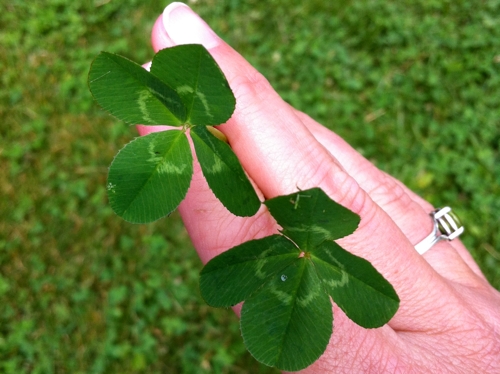There’s a difference between looking and seeing, between hearing and listening. Many of us (I raise my hand) are better at the former than at the latter. We look, but we don’t see. We hear, but we don’t listen.
Over many years of working with visual creatives — designers of all types — I came to admire their highly developed ability to see. Designers look at the world differently than I; they see things I miss.
Turns out, our particular expectations, experience and expertise shapes what we see when we look around us. It’s why a gardener can spot the wildflowers amid the vacant lot full of weeds. It’s why my design friends critique the typography of the menu when we go out to dinner.
Last weekend, I went hunting in the woods for morel mushrooms with an acquaintance. “They’re hard to find,” she said. “But once you spot one, you’ll see them all over the place.” (We never spotted one.) It’s pattern recognition; the same thing comes into play with my odd ability to find 4-leaf clovers.
 Ever feel like you’re missing something when you go out for a walk, or when you’re on vacation? Me, too. Hoping to better develop my ability to pay attention — to really see — I picked up Alexandra Horowitz’s wonderful “On Looking.” I loved her book “Inside of a Dog” (a fascinating read if there’s a beloved canine friend in your life).
Ever feel like you’re missing something when you go out for a walk, or when you’re on vacation? Me, too. Hoping to better develop my ability to pay attention — to really see — I picked up Alexandra Horowitz’s wonderful “On Looking.” I loved her book “Inside of a Dog” (a fascinating read if there’s a beloved canine friend in your life).
In “On Looking,” Horowitz takes walks with 11 “experts” — including illustrator Maira Kalman and type designer Paul Shaw, along with a blind person, an entomologist, a geologist and others. She also walks with her toddler son and her dog, insightful journeys, both.
Bombarded by visual stimuli, she writes, our brains over time develop the ability to filter out everything but what’s critical to our particular mission in the moment, be it finding edible roots or navigating an unfamiliar neighborhood. “Over time” is the key phrase — in infancy, we don’t have those filters.
“One perceptual constraint that I knowingly labor under is the constraint that we all create for ourselves: we summarize and generalize, stop looking at particulars and start taking in scenes at a glance — all in an effort to not be overwhelmed visually when we just need to make it through the day. The artist seems to retain something of the child’s visual strategy: how to look at the world before knowing (or without thinking about) the name or function of everything that catches the eye. An infant treats objects with an unprejudiced equivalence: the plastic truck is of no more intrinsic worth to the child than an empty box is, until the former is called a toy and the latter is called garbage. … To the child, as to the artist, everything is relevant; little is unseen.
“In childhood, all is new. With age, we see things as familiar. We have seen it all before. … Vacations are the adult exceptions. There, two things happen: we actually do see new paces and second, we bother to look. … Soon, though, we acclimate. Before we know it, we have become entirely accustomed to how that vacation spot looks. We have routines, we know the way — and we stop looking.
Want to start looking? I’d recommend “On Looking.” Followed by a slow, inquisitive, attentive walk around your neighborhood.
Worth Reading
In Mindfulness, a Method to Sharpen Focus and Open Minds—Advice on how to quiet your mind’s busy-ness and be aware of your world, by “intentionally paying attention to the present nonjudgmentally.”
Inside of a Dog—by Alexandra Horowitz. “Dogs don’t act on the world by handling objects or by eyeballing them, as people might, or by pointing and asking others to act on the object (as the timid might); instead, they bravely stride right up to a new, unknown object, stretch their magnificent snouts within millimeters of it, and take a nice deep sniff.”